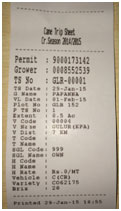Farmers Zone »Technology in Cane Management
Business transformation to a paperless supply chain process – Winner of 2015 Digital Edge 25 International Award for using latest Social, Mobile, Cloud and Analytical technologies to enable a digital enterprise.
CMS in SAP
A robust and well integrated SAP Cane Management module has been developed by NSL SAP team with key business process from cane Offer/plantation to final bill payment. Agriculture loans will be issued against plantation and same will be recovered automatically in the billing. Harvesting schedule will be generated basing on variety rank, plantation date. Trip sheets will be generated at field location through mobile functionality with vehicle particulars. Vehicle tracking system adopted to monitor cane loads. Auto weighment system will capture the cane weights directly from interface. Bulk billing and payment process adopted to generate Growers, Harvesters and Transporters bills. Cane Payments is making through RTGS. Auto SMS alert system adopted to send SMS to growers after generating weighment slip and payment.
-
Mobile Cane Management
Through the field experience it was observed by NSL management that, to have effective cane development and procurement system it is necessary to adopt intervention through information and technology. The features of the system helps to capture real-time date such as offers collection for sugarcane planting, plantation details, farmer registration, information on pest & disease incidence, plotwise alerts for cane developments activities and accuracy in measurement of cane area with help of GPS.
IBHAR- IT intervention for cane management introduced by NSL Sugars Ltd. is fulfilling fallowing objectives.
- Real time monitoring of field activties.
- Improved relationship with farmers by having capability to address issues in real time, getting reliable field data online.
- Addressing the needs of farmers for improving the cane productivity based on field conditions.
- Reduction of manual intervention in data collection and compilation.
-
Use of Hand Refractometer
Hand Refractometer is being used to identify the most mature crop available in the area from the cane data extracted from SAP, maturity survey is being conducted for all plots before release of harvesting program. The entry of Brix reading has been kept as control for issue of cutting order.
Methodology:- Observations to be taken for each plot in the month preceding the planting/harvested month , i.e for crop planted/ harvested in October, observation will be taken in the month of September in such a manner that earlier planted/ harvested crop will be given precedence over late planted/harvested crop. Three observations will be recorded for every plot at a gap of 7 days. Brix data will be recorded in sheet provided for the purpose.
- Brix Observation: Brix reading need to be captured from each plot and 3 Observations to be taken every month.
i) No. of readings per observation per plot:
- For plot of 1 acre extent: 4 reading need to be taken from 4 sides of plot, 10 feet inside from the border.
- For plot of above 1 acre extent: 6 reading need to be taken from 4 sides of plot, 10 feet inside from the border.
ii) Reading/Piercing: three piercing should be carried out as given below:
- Top: 5th internode from top
- Middle: Exact mid of stem
- Bottom: 4th internode from bottom
iii) Average: arithmetic average of the readings should be consider as average Brix of plot
Data Recording: Preprinted observation sheet is being provided to the surveyor which will carry the information of Ryot, plots and date of plantation/harvesting. Data will be recorded in the sheet which will be submitted to the office for feeding in SAP. SAP will use the data while preparing Harvesting Plan.

-
GPS Based Vehicle Tracking
Modern agricultural production continues to become more technology driven with greater use of IT and GPS/GIS. In Sugar industry harvesting and transportation sugarcane is massive task. Furthermore, harvesting and transportation efficiency is very important because sugar quality and content reduces over time taken between harvesting the sugarcane and getting it to the factory should be less than 16 hours. The tracking of cane transport vehicle by using the GPS is the new intervention started by NSL at its sugar plant. The objective of this business process automation is to monitor activities of the vehicles and the field/ work location, daily availability of vehicles in yard and in transit, centralized monitoring and tracking and Optimize and control vehicle trip plans. The system monitor, track and capture presence of vehicles User (supervisor) can view movements of vehicle online in GIS map (Supported Google™ maps) and make appropriate decisions. A reporting system that process the data and present in desired format to view the daily activity of each device. Vehicle movement reports will be provided with number of kilometers travelled, duration of the travel and start and stop locations etc. The validation report generated through the system is inclusive of the place of cutting order issued Vs actual place from where the cane load is transported.
-
IT Architecture















